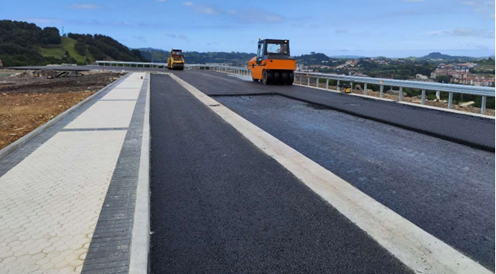REMIBA Project: Use of municipal solid waste slag in granular road surfaces
- Sector: Construction and works
- Motivating factor: Green public procurement, Reduction of waste disposal
- Feasibility: Environmental, technical, economic


The municipal solid waste (MSW) energy recovery plant at the Gipuzkoa Environmental Complex (CMG) generates 40,000 tonnes of incineration slag per year. The usual processes for recovering this waste consist of the separation of unwanted materials, mechanical crushing and screening, separation of metals, and stabilisation in a park. Currently, of the 90,000 tonnes of slag generated annually in the Basque Country, 70,000 tonnes are destined for landfill. Only 20% of the total (the fraction smaller than 10 mm particle size) is being reused in cement factories.
REMIBA is presented as a continuation of the BIRSU project, funded by the Provincial Council of Gipuzkoa. The results and experience acquired in REMIBA could also be applied at the Zabalgarbi plant (Bizkaia), which would make it possible in the medium term to manage all waste of this type generated in the Basque Country.
FCC MEDIO AMBIENTE (FCC) is the developer of REMIBA, for the execution of which it has counted on the TECNALIA Technology Centre and the collaboration of GIPUZKOAKO HONDAKINEN KUDEAKETA (GHK) and URBYCOLAN S.L. The project has been supported by IHOBE, within the Circular Eco-Innovation Programme.
Objectives
- Obtain secondary aggregate solutions from incineration slag as an alternative to natural quarry aggregates in the production of road pavements, also reducing the economic cost of landfill disposal.
- Functional and environmental characterisation of the waste, both on a laboratory scale and in a real use environment.
- To study new treatment alternatives in the laboratory in order to proceed to their industrialisation at a later stage, if necessary.
- Define suitable specifications to serve as a basis for drawing up a future Basque Decree on the recovery of this waste for its inclusion in the Standard for the dimensioning of road surfaces of the Basque Country Road Network and for obtaining the CE Marking.
Results
- Certain leachates and total contents obtained in the characterisation do not comply with the legal limits.
- Development of new treatment alternatives for the waste: separation of fine fraction and irrigation of 125 l/m2.
- Prototypes developed for T2 sections, with percentages between 35% and 75% of slag aggregates.
- Pilot road surface test carried out and experimental validation of final developments in section T3 on the EX2 esplanade in the Eskuzaitzeta Industrial
- Estate (Donostia-San Sebastian), 4 sections of Type 1.1 road surface with 12 cm of asphalt on prototypes of asphalt in 2 layers of 25 cm: a control section (0% slag) and 3 sections with slag at 30, 50 and 70%.
- Emission savings of 9.4 kg CO2 equivalent per tonne of asphalt aggregate and reduction of impacts in all the categories analysed compared to the use of natural aggregate from quarries, due to the raw material procurement phase and the reduction in transport.
- Specifications proposed to the administration with the specifications for the functional and environmental valorisation of incineration slag as aggregate for road surfacing aggregate.
- Submission of the consultation form to EOTA, the European Organisation for Technical Assessment for Construction Products established under the Construction Products Regulation.
Conclusions
- The commercialisation of the proposed solutions will require a new assessment of the leaching results and total content of the material once the Basque Government's Department of the Environment publishes the specific environmental decree for the recovery of incineration slag. This re-evaluation is key to the decision on whether or not to implement the new treatment processes.
- The low resistance to fragmentation of incineration slag makes it necessary to mix it with other, more resistant materials, which entails additional logistical management. In addition, during the execution of the full-scale pilots, difficulties arose in the compaction of the material, requiring longer than usual execution times.
- FCC, GHK and TECNALIA will formally proceed with obtaining CE marking as a construction material for incineration slag within 1-2 years.








